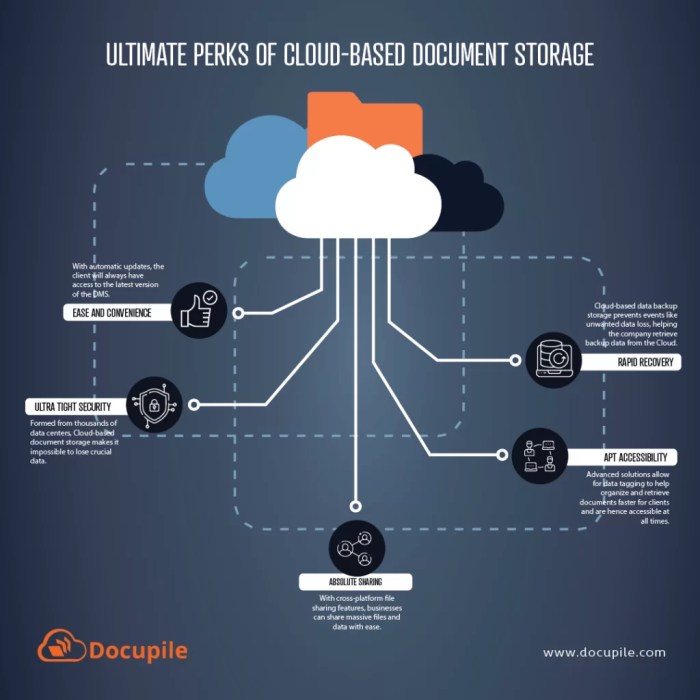Cloud Storage for Documents: The Future of Document Management

In the digital age, cloud storage has revolutionized the way we store and manage our documents. Gone are the days of physical filing cabinets and endless paperwork. With cloud storage, documents can be accessed, edited, and shared from anywhere with an internet connection.
Cloud storage offers a myriad of benefits, including increased accessibility, enhanced collaboration, and improved security. Businesses of all sizes are embracing cloud storage to streamline their document management processes and gain a competitive edge.
Understanding Cloud Storage for Documents

Cloud storage is a model of data storage in which data is stored on remote servers accessed over the internet. It differs from traditional storage methods like local hard drives or USB drives in several ways:
-
-*Accessibility
Cloud storage can be accessed from any device with an internet connection, regardless of location or time.
-*Scalability
Cloud storage can be easily scaled up or down to meet changing storage needs.
-*Reliability
Cloud storage providers typically offer high levels of reliability and redundancy, ensuring that data is protected against loss or corruption.
Benefits of using cloud storage for documents include:
-
-*Convenience
Cloud storage allows you to access your documents from anywhere with an internet connection.
-*Collaboration
Cloud storage makes it easy to share and collaborate on documents with others.
-*Cost-effectiveness
Cloud storage can be more cost-effective than traditional storage methods, especially for large volumes of data.
However, there are also some limitations to using cloud storage for documents:
-
-*Security
Cloud storage providers typically have strong security measures in place, but it’s important to be aware of the potential risks associated with storing data in the cloud.
-*Internet connectivity
Cloud storage requires an internet connection to access your documents. If you lose internet connectivity, you will not be able to access your documents.
-*Privacy
Cloud storage providers may have access to your documents, so it’s important to choose a provider that you trust.
Choosing the Right Cloud Storage Provider
Selecting the ideal cloud storage provider necessitates careful consideration of specific factors.
Understanding your unique storage needs, including file size, frequency of access, and security requirements, is crucial. Research various providers and compare their offerings based on:
- Features: Determine if the provider offers essential features such as file sharing, versioning, and data encryption.
- Security: Evaluate the provider’s security measures, including encryption standards, access controls, and compliance with industry regulations.
- Pricing: Compare pricing plans and determine the cost-effectiveness of each provider based on your storage requirements.
Reliability and Reputation
Reliability is paramount in cloud storage. Consider the provider’s track record, customer reviews, and industry certifications. A reputable provider will offer consistent uptime, robust infrastructure, and responsive technical support. Seek out providers with a proven history of reliability and a commitment to data security.
Best Practices for Using Cloud Storage for Documents
Harnessing cloud storage for document management can amplify productivity and enhance collaboration. To maximize its benefits, implementing best practices is crucial. This includes establishing clear guidelines for document organization and access, implementing robust security measures, and adopting effective version control and backup strategies.
Document Organization and Access
- Establish a well-defined folder structure to organize documents logically, making them easy to locate and retrieve.
- Implement access controls to ensure that only authorized individuals can view, edit, or share specific documents.
- Use metadata tags to categorize documents, facilitating efficient search and retrieval based on relevant criteria.
Security Measures
- Encrypt documents at rest and in transit to safeguard sensitive information from unauthorized access.
- Enable two-factor authentication for enhanced account security and prevent unauthorized logins.
- Implement access logs to monitor user activity and identify any suspicious or unauthorized actions.
Version Control and Backup Strategies
- Enable version control to track changes and revert to previous versions if necessary, ensuring data integrity.
- Implement regular backups to create redundant copies of important documents, protecting against data loss in case of system failures or accidental deletions.
- Store backups in a separate location to mitigate the risk of data loss due to localized incidents.
Advanced Features and Integrations
Cloud storage for documents offers advanced features and integrations that enhance document management and collaboration. Optical character recognition (OCR) technology enables the conversion of scanned documents into editable text, making them searchable and accessible.
Cloud storage providers also integrate with various productivity tools and applications, such as document editors, project management platforms, and email clients. This integration allows for seamless document sharing, editing, and collaboration within a single platform.
Optical Character Recognition (OCR)
- Converts scanned documents into editable text
- Enables search and indexing
- Facilitates document editing and collaboration
Document Sharing and Collaboration
- Share documents securely with internal and external users
- Control access permissions and track document activity
- Integrate with productivity tools for seamless editing and collaboration
Case Studies and Real-World Examples

introThis section presents case studies and real-world examples of how businesses have successfully implemented cloud storage solutions to enhance their document management processes. We’ll highlight specific challenges faced by these organizations and the innovative solutions they employed to overcome them.
Case Study 1
Challenge:
Acme Corporation, a global manufacturing company, struggled with managing a vast and rapidly growing collection of documents across multiple locations. Their existing on-premises storage system was inadequate, leading to inefficiencies, security concerns, and difficulty in accessing documents remotely.
Solution:
Acme implemented a cloud storage solution that provided centralized access to all their documents, regardless of location. This enabled employees to securely access and collaborate on documents from anywhere, enhancing productivity and streamlining workflows.
Case Study 2
Challenge:
Sakura Consulting, a financial services firm, faced challenges with compliance and data security. They needed a reliable and secure solution to store and manage sensitive client data while ensuring compliance with industry regulations.
Solution:
Sakura deployed a cloud storage solution that met the highest security standards and provided robust data protection features. This enabled them to securely store and manage client data, ensuring compliance and protecting against unauthorized access.
Case Study 3
Challenge:
TechX, a software development company, needed a cost-effective and scalable solution to store and manage their rapidly growing codebase. Their existing storage solution was expensive and couldn’t keep up with the company’s growth.
Solution:
TechX migrated their codebase to a cloud storage solution that offered scalability and cost-effectiveness. This allowed them to store and manage their code efficiently, reducing storage costs and enabling seamless collaboration among development teams.
Last Word
Cloud storage is not just a trend; it is the future of document management. By embracing cloud storage, businesses can unlock a world of possibilities and transform the way they manage their documents.









